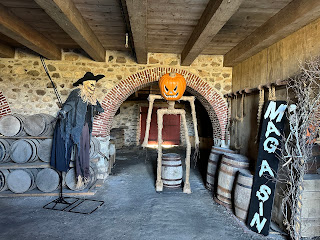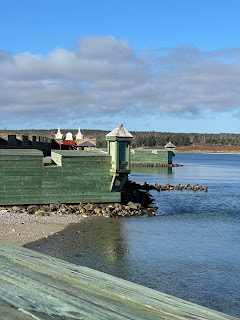Our stop in Sydney, Nova Scotia gave us the opportunity to visit Fortress of Louisbourg, the story of which is a staple of grade school Canadian history. The fortress is a recreation run by Parks Canada, but it is surrounded by active archaeological sites which are yielding more and more information on how the settlers and militia lived there in the mid 1700s.
The fortress was built between 1719 and 1745 by the French, who had only a couple of very small island holdings left here after they lost Acadia and Newfoundland to the British. One of these was Cape Breton Island, then known as Ile Royale, where Louisbourg was established as a cod fishing community. Because of the constant shipment of fish back to France, Louisbourg also became a trading hub for goods from Quebec, the West Indies and New England.
In 1745, after a declaration of war between England and France, the New Englanders attacked from the land side, not the harbour. According to our tour guide, who was a retired teacher, they must have been really riled up as they fought their way through forests of black pine trees to get there. That meant also fighting black flies and mosquitoes that could literally eat you alive. As we learned at the fortress, the militia stationed at Louisbourg was so poorly treated that the soldiers were on the verge of mutiny, so it only took them 46 days to take the town. Unfortunately, it was returned to the French three years later by the Treaty of Aix-la-Chapelle.
The town was again taken by the British in 1758, this time from the sea. The French did not have any strong naval protection for the town, and against 150 ships it only took 7 weeks for the British to capture it. They then destroyed the fortification walls around Louisbourg to ensure it would never again be used as a French military base.
 |
| One of the gates to the town from the harbour |
 |
| The chapel |
 |
| The large courtyard behind the King's Bastion. This building included the soldiers' barracks, the chapel and the Governor's residence |
 |
| We noticed some of the town's sheep invading the ramparts - more on them later. |
 |
| The homes have been recreated as accurately as possible, down to the plants that would have been growing in the gardens |
We of course showed up in probably the last week of the season for the Fortress, so some of the buildings were already closed and only a few of the people representing the inhabitants were still there. We had an interesting description of what it was like to be a soldier, as well as a musket firing demonstration, and then we visited the Engineer's Residence for hot chocolate and a description of life for the average settler in the town.









No comments:
Post a Comment